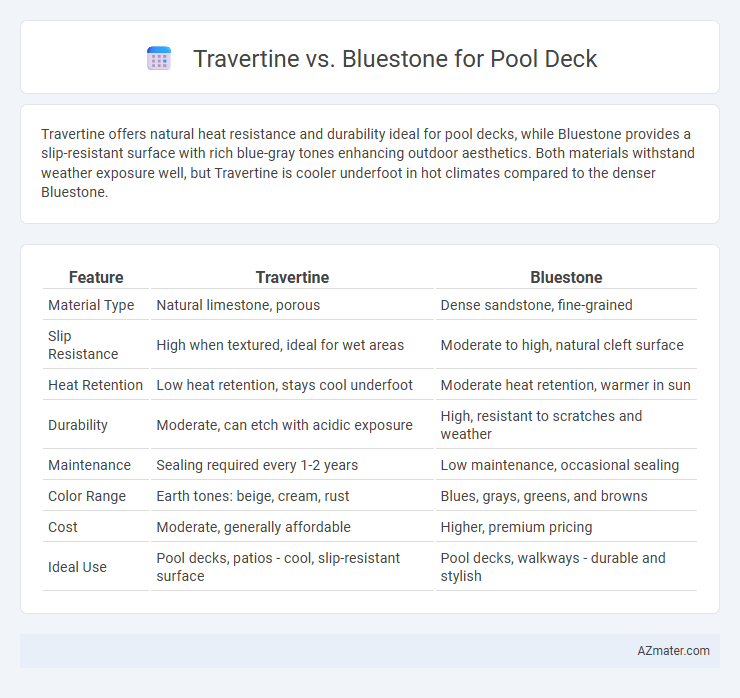Travertine offers natural heat resistance and durability ideal for pool decks, while Bluestone provides a slip-resistant surface with rich blue-gray tones enhancing outdoor aesthetics. Both materials withstand weather exposure well, but Travertine is cooler underfoot in hot climates compared to the denser Bluestone.
Table of Comparison
| Feature | Travertine | Bluestone |
|---|---|---|
| Material Type | Natural limestone, porous | Dense sandstone, fine-grained |
| Slip Resistance | High when textured, ideal for wet areas | Moderate to high, natural cleft surface |
| Heat Retention | Low heat retention, stays cool underfoot | Moderate heat retention, warmer in sun |
| Durability | Moderate, can etch with acidic exposure | High, resistant to scratches and weather |
| Maintenance | Sealing required every 1-2 years | Low maintenance, occasional sealing |
| Color Range | Earth tones: beige, cream, rust | Blues, grays, greens, and browns |
| Cost | Moderate, generally affordable | Higher, premium pricing |
| Ideal Use | Pool decks, patios - cool, slip-resistant surface | Pool decks, walkways - durable and stylish |
Introduction: Choosing the Right Pool Deck Material
Travertine and bluestone both offer durable, attractive options for pool decks, with travertine prized for its natural thermal resistance and classic beige tones, while bluestone provides a denser surface with rich blue-gray hues. Travertine's porous structure aids in slip resistance and heat dispersion, making it ideal for hot climates, whereas bluestone's hardness and uniform texture enhance longevity but may retain more heat. Selecting between travertine and bluestone depends on factors like climate, aesthetic preference, and maintenance requirements, ensuring the pool deck withstands moisture, sun exposure, and foot traffic effectively.
Understanding Travertine: Key Features and Benefits
Travertine is a natural stone renowned for its durability, non-slip surface, and heat-resistant properties, making it an ideal choice for pool decks. Its porous texture allows for excellent water drainage, reducing the risk of slipping and enhancing safety around wet areas. The stone's elegant appearance, available in warm beige, ivory, and tan tones, adds a timeless aesthetic while maintaining low maintenance requirements.
What Is Bluestone?: Characteristics and Appeal
Bluestone is a dense, natural stone known for its durability, slip resistance, and attractive blue-gray hues, making it a popular choice for pool decks. Its fine-grained texture and natural cleft surface provide excellent traction even when wet, enhancing safety around pools. Bluestone's ability to withstand harsh weather and resist heat absorption adds to its appeal as a low-maintenance, long-lasting option for outdoor pool decking.
Slip Resistance and Safety Comparison
Travertine offers superior slip resistance for pool decks due to its naturally textured surface, making it a safer choice around wet areas. Bluestone, although visually appealing with its smooth, dense finish, can become slippery when wet, posing a higher risk of falls. For pool deck safety, travertine's porous structure provides better traction and reduces slip hazards compared to bluestone.
Heat Retention: Which Stays Cooler Underfoot?
Travertine pool decks exhibit lower heat retention compared to bluestone, making them cooler underfoot during hot weather due to their natural porous structure that helps dissipate heat. Bluestone, a dense metamorphic rock, tends to absorb and retain more heat, leading to warmer surfaces in direct sunlight. Choosing travertine enhances comfort around pools by reducing footburn risks and maintaining a cooler walking surface.
Aesthetic Differences: Style and Design Options
Travertine pool decks offer a natural, warm aesthetic with earth-toned hues and distinctive pitted textures that complement Mediterranean and rustic styles. Bluestone features a sleek, smooth surface with a range of blue-gray shades, providing a modern and elegant look suited for contemporary designs. The choice between travertine and bluestone shapes the overall ambiance, with travertine emphasizing organic warmth and bluestone delivering a refined, cool-toned appearance.
Durability and Maintenance Requirements
Travertine offers excellent durability with natural resistance to cracking and heat, making it ideal for pool decks in warm climates, while bluestone is exceptionally hard and dense, providing strong resistance to wear and weathering. Maintenance for travertine involves regular sealing to prevent water absorption and staining, whereas bluestone requires less frequent sealing but benefits from routine cleaning to maintain its slip-resistant surface. Both materials provide durable options, but travertine demands more upkeep to preserve its appearance and longevity around pools.
Cost Analysis: Travertine vs Bluestone
Travertine pool decks typically cost between $12 to $25 per square foot, offering a mid-range price point with natural heat resistance and slip-resistant properties. Bluestone, often priced higher at $15 to $30 per square foot, provides superior durability and a unique aesthetic but may require additional sealing and maintenance costs over time. Evaluating the total cost of ownership, including installation, maintenance, and longevity, Travertine offers a more budget-friendly option while Bluestone commands a premium for enhanced strength and visual appeal.
Environmental Impact and Sustainability
Travertine offers a natural, porous surface that requires less energy-intensive processing compared to bluestone, making it a more sustainable choice for eco-conscious pool decks. Bluestone, while durable and dense, involves quarrying methods that can have a higher environmental footprint due to significant extraction and transportation impacts. Choosing travertine supports reduced carbon emissions and promotes the use of a renewable, biodegradable material, aligning with sustainable landscaping practices.
Final Verdict: Which Material Is Best for Your Pool Deck?
Travertine offers superior heat resistance and a natural non-slip surface, making it ideal for pool decks in hot climates, while Bluestone provides exceptional durability and a sleek, modern aesthetic with excellent slip resistance. Choosing between Travertine and Bluestone depends on your priority for comfort underfoot and regional climate conditions, with Travertine excelling in warmth management and Bluestone outperforming in long-term wear and maintenance. For a pool deck balancing safety, style, and longevity, Travertine suits warmer areas, whereas Bluestone is optimal for cooler environments requiring enhanced toughness.

Infographic: Travertine vs Bluestone for Pool Deck
 azmater.com
azmater.com